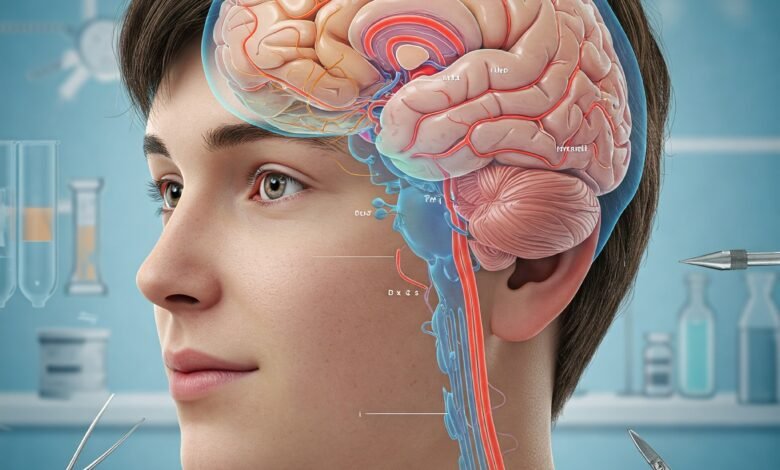Understanding the Teenage Brain: Why Adolescents Think and Act Differently

Introduction to Adolescent Brain Development
The adolescent phase is a pivotal period marked by significant transformations in brain development. During this critical time, which typically ranges from ages 10 to 19, the human brain undergoes a series of profound physiological changes. These alterations are essential for fostering cognitive abilities and emotional regulation that define adulthood. The brain does not reach its full maturity until well into the mid-20s, making adolescence a unique window for both growth and vulnerability.
One of the most notable changes in the adolescent brain is the maturation of the prefrontal cortex, responsible for higher-order cognitive functions such as decision-making, impulse control, and reasoning. This region of the brain develops steadily through the teenage years, yet it is often outpaced by the growth of the limbic system, which governs emotions and social interactions. The disparity between these developments can lead to increased emotional reactivity and risk-taking behaviors commonly observed in teenagers. This uneven maturation is crucial to understanding why adolescents might engage in questionable activities or display erratic behaviors.
Additionally, the process of synaptic pruning occurs, whereby unused neural connections are eliminated, optimizing brain efficiency. This process is influenced by environmental factors, experiences, and learning opportunities, highlighting the importance of positive social interactions and educational pursuits during this time. Furthermore, myelination—whereby nerve fibers become insulated—improves the speed and efficiency of communication between different brain regions, enhancing the overall cognitive capacity of adolescents.
Understanding these core aspects of adolescent brain development is essential for parents, educators, and mental health professionals. It provides insight into the behaviors and thought patterns typical of this age group, offering valuable perspectives that can assist in fostering a supportive environment as they navigate this significant phase of growth.
Key Differences in Teenage Brain Structure
The structure of the teenage brain undergoes significant transformations when compared to adult brains, leading to distinct differences in cognition and behavior. One of the most notable changes occurs in the composition of gray and white matter. Gray matter, which comprises neuronal cell bodies and is essential for processing information, peaks during adolescence before gradually diminishing into adulthood. This reduction is often attributed to a process called synaptic pruning, whereby excess neural connections are eliminated, allowing for increased efficiency and specialization within the brain.
Conversely, white matter, composed of myelinated axons that facilitate communication between brain regions, continues to develop throughout adolescence. This maturation means that, while teenagers are gaining speed and connectivity in their brain networks, they are also navigating a landscape marked by fluctuating gray matter. The interplay between these two types of matter contributes to the variability in emotional responses and decision-making capabilities observed in adolescents.
Particularly critical to understanding adolescent behavior is the development of the prefrontal cortex and the limbic system. The prefrontal cortex, responsible for higher-order functions such as reasoning, impulse control, and decision-making, matures later than the limbic system, which governs emotional responses and reward processing. This asynchronous development can result in teenagers behaving impulsively or taking risks, often driven by the heightened emotional response from the limbic system, while lacking the fully developed reasoning capabilities from the prefrontal cortex. These structural differences highlight why adolescents may think and act differently compared to adults, emphasizing the unique neurodevelopmental stage they are in.”
The Role of the Limbic System in Emotion and Behavior
The limbic system plays a crucial role in shaping the emotional and behavioral patterns of adolescents. This complex network of brain structures is primarily responsible for processing emotions and storing memories, deeply influencing how teenagers perceive their environment and react to stimuli. One key component of the limbic system is the amygdala, which is particularly involved in the assessment of emotional significance. During adolescence, the amygdala exhibits heightened activity, leading to increased emotional reactivity and impulsive behaviors.
As the limbic system develops, it tends to mature faster than the prefrontal cortex, a region associated with logic and decision-making. This disparity contributes to the paradox often observed during teenage years: while adolescents experience intense emotions, their ability to regulate and respond to these feelings rationally is still developing. Consequently, teenagers may often engage in risk-taking behaviors or display emotional responses that appear irrational to adults.
The influence of the limbic system extends to social interactions, peer relationships, and the pursuit of pleasurable experiences. Adolescents frequently seek out situations that yield immediate gratification, even when potential risks are evident. This can lead to choices that prioritize short-term rewards over long-term consequences, as the emotional drivers in the limbic system overshadow rational thought processes.
Additionally, the heightened sensitivity to rewards during this developmental stage can encourage adolescents to engage in thrill-seeking behaviors, such as experimenting with substances or seeking out extreme activities. These behaviors are integral to their exploration of identity, autonomy, and even social acceptance. Understanding the limbic system’s influence on emotions and behavior provides critical insights into the challenges adolescents face, highlighting the necessity for guidance and support during this tumultuous period of development.
Prefrontal Cortex Development and Decision Making
The prefrontal cortex (PFC) plays a vital role in higher-order cognitive functions, including decision-making, impulse control, and self-regulation. During adolescence, the prefrontal cortex undergoes significant developmental changes that contribute to how teenagers think and behave. Research indicates that while many areas of the brain mature, the PFC often lags behind, resulting in a disparity between emotional and rational thinking during these formative years. This developmental stage is critical in understanding why adolescents tend to make choices that favor immediate gratification over long-term benefits.
In teenagers, the prefrontal cortex is still refining its neural connections, which influences their ability to evaluate risks and consequences effectively. As this brain region evolves, it enhances the capacity for planning, critical thinking, and understanding future implications of their actions. However, the immaturity of the PFC can lead to impulsivity, a hallmark of adolescent behavior. This impulsivity often manifests as a preference for short-term rewards, as the ability to weigh future consequences remains underdeveloped. For instance, adolescents might prioritize social acceptance or thrill-seeking over academic responsibilities, reflecting their current cognitive state.
Social Influences on Teenage Behavior
The teenage years represent a pivotal period of development, characterized by significant cognitive and emotional transformations. One salient aspect of this developmental stage is the profound impact of social influences on adolescents’ behavior and thought processes. Peer pressure, for example, serves as a compelling force that often drives teenagers to conform to group norms, sometimes at the expense of their individual values or judgments. The need for social acceptance can lead to participation in behaviors that may not align with their true selves, illustrating the intricate interplay between social dynamics and evolving brain functions.
During adolescence, the prefrontal cortex, responsible for decision-making and self-regulation, undergoes substantial maturation, while the limbic system, which governs emotions and social interactions, remains highly active. This neurological dichotomy results in heightened emotional responses and a tendency to prioritize peer relationships. Consequently, teens are often more susceptible to peer influences, which can manifest in various forms, including substance use, risky behaviors, and even academic choices. The urgent desire to fit in can thus exert a powerful sway over their decision-making processes.
Moreover, the pervasive nature of social media has added another layer of complexity to teenage social interactions. Platforms such as Instagram, Snapchat, and TikTok serve as both venues for social connection and sources of social comparison. Images and portrayals of idealized lifestyles can shape adolescents’ self-image, often leading to feelings of inadequacy and anxiety. This virtual landscape can amplify peer pressure, as teenagers frequently assess their worth against the curated lives of others, resulting in fluctuating self-esteem and potential mental health concerns. The intertwining of social awareness, media influence, and neurological changes underscores the critical importance of understanding these dynamics in the context of adolescent behavior.
Risk-Taking: An Evolutionary Perspective
Risk-taking behavior during adolescence is often seen as an irrational characteristic of youth, yet from an evolutionary standpoint, it serves several critical functions that may have contributed to the survival and advancement of the human species. Evolutionarily, this phase of life is marked by a heightened propensity to seek out new experiences and venture into the unknown, behaviors which were essential for early humans as they navigated their environment.
Young individuals, in their quest for independence and identity, engage in risk-taking to explore their surroundings and establish social connections. The impulse to take risks is an inherent trait that encourages adolescents to leave the safety of their family units and venture into broader social landscapes. This exploration is crucial for learning about potential dangers and opportunities, effectively preparing them for adult roles where independence is vital for survival.
Moreover, engaging in risky behaviors can foster social bonding among peers. Adolescents often seek validation from their peers, and partaking in shared risky experiences, such as extreme sports or social challenges, solidifies group identity and cohesion. This bonding is integral in teaching valuable social skills and strategies that are necessary for future collaboration in adult endeavors.
From a biological perspective, adolescence is characterized by significant neurological changes, particularly in the prefrontal cortex, which governs decision-making and impulse control. While this development continues well into the twenties, it allows for exploration and flexibility in decision-making during adolescence. The balance between risk-taking and caution underscores an adaptation strategy that propels young individuals to learn from their environment, thereby ultimately enhancing their survival and integration into adult society.
Hence, while risk-taking may present challenges and potential dangers, it is necessary to recognize its evolutionary benefits. These behaviors not only promote personal growth but also foster essential social development, contributing to a deeper understanding of the adolescent experience.
Mental Health Challenges in Adolescents
The transition from childhood to adulthood is marked by significant developmental changes, particularly in the brain. During adolescence, individuals experience a period of rapid neurological growth and restructuring that can impact their mental health. Research indicates a concerning increase in mental health challenges, including anxiety and depression, during these formative years. This rise can be attributed not only to inherent brain changes but also to a variety of environmental stressors.
The adolescent brain undergoes critical transformations, particularly within the prefrontal cortex and limbic system. The prefrontal cortex, which is responsible for decision-making, impulse control, and emotional regulation, is still maturing during this period. On the other hand, the limbic system, associated with emotions and reward-seeking behaviors, develops more rapidly. This imbalance can lead to heightened emotional responses and a propensity for risky behaviors, increasing vulnerability to mental health issues.
Various environmental factors also contribute to mental health challenges in adolescents. These include academic pressures, social media influences, and familial dynamics. The advent of social media has particularly intensified feelings of inadequacy and anxiety, as adolescents often compare themselves to their peers. Additionally, the expectations placed upon young people in school can lead to overwhelming stress, fostering a climate where anxiety and depression can thrive.
Understanding these neurological changes and external influences is crucial for supporting adolescents effectively. Support systems, including families, educators, and mental health professionals, must be aware of the specific challenges faced by young people during this developmental stage. By fostering an environment that promotes open communication and mental well-being, society can better equip adolescents to navigate these challenges and develop resilience.
Strategies for Supporting Teenagers’ Development
Supporting adolescents during these formative years requires a comprehensive understanding of their unique developmental needs. One of the most effective strategies for parents, educators, and mentors is fostering open communication. Creating a space where teenagers feel comfortable expressing their thoughts and feelings is crucial. This can be achieved by actively listening to them, validating their emotions, and providing them with guidance without being judgmental. When teenagers know they can speak freely, they are more likely to share concerns and challenges, which in turn helps adults to better support them.
It is also essential to acknowledge and understand the limitations of the teenage brain. Research indicates that during adolescence, the prefrontal cortex, responsible for decision-making and impulse control, is still developing. Thus, teenagers may struggle with certain cognitive tasks and risk assessment. Educators and parents should not only recognize this but also help adolescents navigate these challenges. Providing clear, consistent expectations and boundaries while encouraging them to weigh the consequences of their actions can cultivate better decision-making skills.
Creating an environment that promotes healthy risk-taking is another vital strategy for supporting teenagers’ development. Adolescents often seek new experiences and challenges, which can positively contribute to their growth when guided appropriately. By encouraging involvement in extracurricular activities, sports, or creative pursuits, adults can provide structured opportunities for teenagers to explore their interests while also learning valuable life skills. Additionally, fostering emotional resilience is paramount; teaching teenagers how to cope with setbacks and manage stress effectively prepares them for future challenges. Overall, by employing these strategies, parents, educators, and mentors can significantly enhance adolescents’ development, empowering them to thrive during this critical period of their lives.
Conclusion: Embracing the Teenage Experience
Understanding the complexities of the teenage brain is crucial for both parents and educators. Throughout this discussion, we have explored key aspects of adolescent brain development, highlighting how these changes influence behavior, decision-making, and emotional regulation. The teenage years are marked by significant neurological growth and transformation, including increased connectivity within the prefrontal cortex and changes in the limbic system, which are essential for reasoning and emotion.
The unique characteristics of adolescence can often lead to misunderstandings and challenges; however, it is essential to approach this phase with empathy and patience. By acknowledging the intense feelings, risk-taking behaviors, and shifting identities of teenagers, we can foster a supportive environment that nurtures their growth. Rather than viewing these tendencies as problematic or rebellious, it is more productive to recognize them as a natural part of development. Encouraging open communication and offering guidance can help adolescents navigate this tumultuous period effectively.
Additionally, understanding the impact of external factors such as peer relationships, family dynamics, and societal expectations is vital. These elements play a role in shaping the teenage experience and influencing their choices. By being mindful of these influences, parents and educators can better support adolescents in making informed decisions that reflect their values and aspirations.
In conclusion, embracing the teenage experience means recognizing the profound changes that occur within the adolescent brain. These years are not merely a passage of turbulence but rather an essential period in human development that lays the foundation for adulthood. By fostering an environment of understanding and support, we can help guide teenagers through these formative years, equipping them with the tools they need to thrive both now and in the future.






















